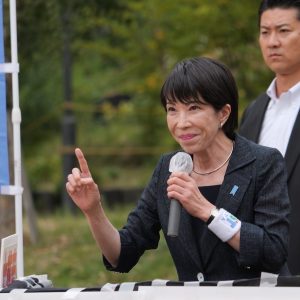October 4 was a historic day for Japanese politics. Takaichi Sanae, Japan’s former minister for economic security, won the presidential election of Japan’s ruling Liberal Democratic Party (LDP) to become the first female president in the party’s history. She is now poised to make history again and become the first female prime minister of Japan when the Diet resumes, breaking the ultimate glass ceiling in Japanese politics.
Her victory on Saturday defied everyone’s expectations. Analysts in Japan across the political spectrum expected Koizumi Shinjiro, the articulate and charismatic son of popular former Prime Minister Koizumi Junichiro, to succeed Ishiba Shigeru. His victory would have been epoch-making in its own right, as he would have been the youngest leader in LDP history. However, Takaichi’s expected ascension as the first female prime minister of Japan carries a different level of magnitude.
As expected, many post-game analyses pointed to the headwinds that Takaichi will face. First and foremost is whether she can add another partner to LDP’s current ruling coalition before the vote to select the next prime minister of Japan is expected to take place in mid-October. Currently, there are two obvious candidates as an additional coalition partner: Nippon Ishin no Kai and the Democratic Party for the People (DPFP). Each party has policies where they are aligned closer with the LDP – and other policies where they are father away.
In addition, Takaichi needs to heed the comfort level of LDP’s longtime coalition partner Komeito, which is already bracing for the prospect that she might take the LDP farther to the right based on her reputation as a conservative politician.
Others suggest that Takaichi herself will be overshadowed by the influence of former Prime Minister Aso Taro, who played a pivotal role in rounding up the support for her among the LDP politicians in her run-off vis-à-vis Koizumi. Before the voting, many veteran political observers in Japan pointed out that the October 4 election was a “proxy war” among three LDP former prime ministers dubbed as “king makers” – Suga Yoshihide, Kishida Fumio, and Aso – who have been jockeying to retain political influence within the party.
Following Takaichi’s victory, analysts say she will have to “reward” Aso and his proteges by appointing them to senior positions in the LDP leadership and/or the Cabinet. Her initial moves on the LDP leadership positions – the appointment of Suzuki Shunichi, Aso’s brother-in-law, to LDP’s secretary general, in particular – already point to the inner LDP political dynamics Takaichi will have to navigate.
Of course, Takaichi has no shortage of policy challenges once she becomes the prime minister. At her first press conference as the LDP president, she indicated that her top priority is to tackle inflation and tax relief for Japanese people. However, as important as these economic issues are, they are only the beginning of a long list of domestic and foreign policy challenges Takaichi will have to navigate.
There are pressing domestic political issues – including resorting voter confidence in the LDP, which has been reduced to minority status in both houses of the Diet, as well as inflation and immigration. Then there are the foreign policy challenges such as worsening threats from China and North Korea, maintaining the positive momentum in Japan-South Korea relations, and the looming possibility of Takaichi having to face U.S. President Donald Trump within a mere 2 weeks of being the prime minister. It almost looks as though, as some media outlets already pointed out, becoming Japan’s first female prime minister is the “easy part” for Takaichi.
Takaichi has to lead LDP and, if elected, Japan through a political landscape full of landmines. The most important challenge moving forward is whether she can fight the reflex of having to prove her conservative reputation.
Ironically, Takaichi was not always known for her conservative policy views. While she has always been a strong advocate for a robust Japan-U.S. alliance, her reputation as a conservative politician became more pronounced after she joined the LDP in 1996, several years after she was first elected to the House of Representatives in 1993 and joined Seiwa-Kai, the conservative group within the LDP that counted former prime ministers Koizumi Junichiro and Abe Shinzo as members. In other words, unlike Koizumi and Abe – who were thoroughbreds that had always represented the conservative wing of the LDP – Takaichi has always had to “prove her worth” to conservatives as she rose up the ranks in the party.
Now that Takaichi is about to make the history and become Japan’s first female prime minister, it will be imperative for her to have the courage to choose a road as a pragmatic leader, following the footsteps of her mentor, the late Abe.
Takaichi is already signaling that she will prioritize pragmatism over her political ideology. For instance, she referred to close Japan-South Korea-U.S. trilateral cooperation among her top foreign policy priorities. Throughout the campaign for LDP presidency, she tried to temper her conservative rhetoric. When asked by the press about the prospect of her visiting Yasukuni Shrine – often the litmus test for LDP members for their conservatism – her response closely paralleled Abe’s past stance: she said she would “make an appropriate decision at that time.”
It’s well known that Takaichi holds former British Prime Minister Margaret Thatcher as her role model. As she tries to become Japan’s own Thatcher, Takaichi’s success depends not on whether she can push forward specific policies such as Abenomics-like economic policies or a bigger defense budget. Rather her true path to become “Japan’s Iron Lady” depends on her own political courage to demonstrate her adaptability and flexibility as a leader.



























